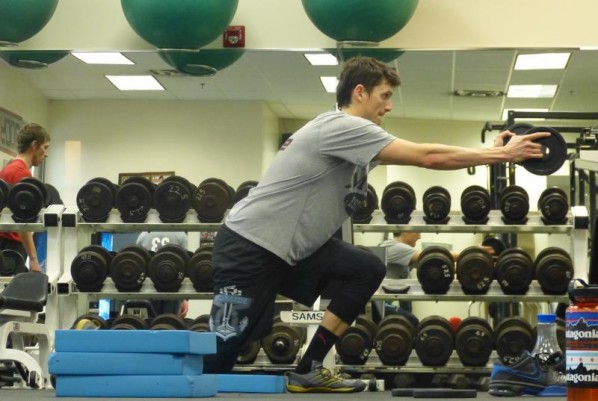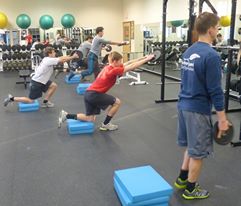
Tim, if you could pick just 1 exercise to give to the ultimate community improving athleticism and decreasing the dreaded amount of injuries that we see, what would it be?
Although the Hang Power Clean and the SLDL come to mind, my hands-down answer is the Skater Squat.
How pretty commonplace it could be if the ultimate community would get away from the bilateral lifts, the Crossfit, the powerlifting and adopt a functional training model? If all ultimate athletes would add Skater Squats to their regimens, we would have a drastic decrease in ACL and other knee injuries. Our cutting, sprinting and jumping would improve, and a lot of the poor movement patterns we see would be replaced with functional patterns.
Why is the Skater Squat so important?
When ultimate players run, jump and cut, these movements are happening on a single leg. We rotate and pivot constantly on the same side. The act of practicing and playing ultimate is a breeding ground for asymmetry, which elads to inefficiency and injury. There is no way around it.
We have to come to an understanding of our bodies– particularly our hips– and how to train them for function, symmetry, and performance.
Squatting variations are one of the best things we can do to create symmetry. However, we need to train stability just as much as we train symmetry. A bilateral Squat does not challenge our stability whatsoever. A Split Squat, on the other hand, is awesome. It’s the precursor to the Split Jump Progression, but the back leg is there for stability and is doing about 40 % of the work. A Rear Foot Elevated Split Squat is even better, but still the back leg is in contact to the bench assist in stability and is doing approximately 20 % of the work.
When we do Skater Squats, the back leg is free, leaving the front leg to do all the stabilizing! This gives us what we are after if we want to develop true stability that will transfer to our sprinting and single leg jumping. Let’s look at some of the benefits of doing this awesome exercise:
- Creates knee and hip stability.
- Trains a stable arch.
- Quad and glute/hamstring development.
- Develops single leg strength.
- Teaches neutral spine.
- Transfers to the landing position of a HOP or 1-2 Stick (essential drills for developing bulletproof knees).
- Decreases the risk of ACL and other knee injuries by teaching the anke/knee/hip to be strong and stable.
Why not just pistol squat, Timmy?
I dislike pistol squats. You should stop doing them. When most people pistol, they completely exhaust the ankle range of motion, causing the knee to be way in front of the toe and thereby creating an anterior / quad dominant exercise. Squatting should be the first hinge, and we should only dip into our ankle range if we need to. We need to get back on our heel and develop our glutes any chance we get! When we do Skater Squats, the free leg goes back, creating a more vertical tibia which allows us to engage the glutes as well as the quads. Further, pistols create a rounded back. We want to train with a neutral spine as often as possible (while I’m at it, stop deadlifting with a rounded back, please. It’s too heavy!).
How do I build up to this?
Alright yall, here is the Skater Squat Progression. Don’t just watch these videos! Add this exercise to your program! It will make a difference.
Phase 1: Skater Squat
Phase 2: Deficit Skater Squat
Loaded Deficit Skater Squat (JAM MODE)
Variations:
Reach Across Skater Squat for Improved Glute Firing
RNT Skater Squat:
Troubleshooting the Skater Squat:
- Feel tension in the front of the knee? Make sure your weight is on your heel. Reach up high with the counterbalance weights and reach your free leg way back.
- Can’t go full range? You may be lacking ankle mobility. Try this drill. You may be lacking hip mobility. Try this one out. Also consider using 2-4 pads to start. Work your way towards the full drill.
- Back Rounding? Don’t go as deep. Use light weights for counter balance.
- Knee collapsing in? Create a stable arch. Add in this drill to activate your hip rotators.
- Still having trouble? You may just need to practice! Reps, reps reps!
Thanks for reading guys. Thank you for supporting Skyd, Morrill Performance, Ultimate and awesomeness. Let’s dominate 2014. If I can help you in any way, e-mail me at morrillperformance@gmail.com.











Comments Policy: At Skyd, we value all legitimate contributions to the discussion of ultimate. However, please ensure your input is respectful. Hateful, slanderous, or disrespectful comments will be deleted. For grammatical, factual, and typographic errors, instead of leaving a comment, please e-mail our editors directly at editors [at] skydmagazine.com.